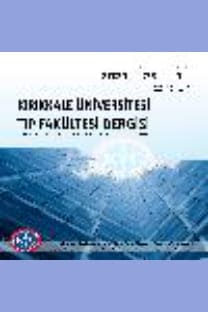KAN KÜLTÜR ŞİŞE SAYISI UYGUNLUĞUNUN ARAŞTIRILMASI
___
- 1. Bearman GM, Wenzel RP. Bacteremias: a leading cause of death. Arch Med Res. 2005; 36:646–659.
- 2. Wisplinghoff H, Bischoff T, Tallent SM, Seifert H, Wenzel RP, Edmond MB. Nosocomial bloodstream infections in US hospitals: analysis of 24,179 cases from a prospective nationwide surveillance study. Clin Infect Dis. 2004; 39:309–317.
- 3. Bates DW, Cook EF, Goldman L, Lee TH. Predicting bacteremia in hospitalized patients. A prospectively validated model. Ann Intern Med. 1990; 113:495–500.
- 4. Cockerill FR 3rd, Wilson JW, Vetter EA, Goodman KM, Torgerson CA, Harmsen WS, Schleck CD, Ilstrup DM, Washington JA 2nd, Wilson WR. Optimal testing parameters for blood cultures. Clin Infect Dis. 2004; 38:1724–1730.
- 5. Mylotte JM, Tayara A. Blood cultures: clinical aspects and controversies. Eur J Clin Microbiol Infect Dis. 2000; 19:157–163.
- 6. Reimer LG, Wilson ML, Weinstein MP. Update on detection of bacteremia and fungemia. Clin Microbiol Rev. 1997;10:444–465.
- 7. MP Weinstein MP, Reller LB, Murphy JR, Lichtenstein KA. The clinical significance of positive blood cultures: a comprehensive analysis of 500 episodes of bacteremia and fungemia in adults. Laboratory and epidemiologic observations. Rev Infect Dis. 1983;5:35–53.
- 8. Reimer LG, Wilson ML, Weinstein MP. Update on detection of bacteremia and fungemia. Clin Microbiol Rev. 1997;103:444–465.
- 9. Cockerill FR, Wilson JW, Vetter EA. Optimal testing parameters for blood cultures. Clin Infect Dis. 2004;38:1724–1730.
- 10. Lee A, Mirrett S, Reller LB, Weinstein MP. Detection of bloodstream infections in adults: how many blood cultures are needed? J Clin Microbiol. 2007; 45:3546–3548.
- 11. Dargère S, Parienti JJ, Roupie E, Gancel PE, Wiel E, Smaiti N, Loiez C, Joly LM, Lemée L, Pestel-Caron M, du Cheyron D, Verdon R, Leclercq R, Cattoir V; UBC study group. Unique blood culture for diagnosis of bloodstream infections in emergency departments: a prospective multicentre study. Clin Microbiol Infect. 2014;11:920-927.
- 12. Kan kültürü uygulama kılavuzu. Ed. Ahmet Başustaoğlu. Ankara 2013
- 13. Washington, J. A. Blood cultures: principles and techniques. Mayo Clin. Proc. 1975; 50:91–98.
- 14. Weinstein MP, Reller LB, Murphy JR, Lichtenstein KA. The clinical significance of positive blood cultures: a comprehensive analysis of 500 episodes of bacteremia and fungemia in adults. I. Laboratory and epidemiologic observations. Rev Infect Dis 1983;5:35–53.
- 15. Vitrat-Hincky V, François P, Labarère J, Recule C, Stahl JP, Pavese P. Appropriateness of blood culture testing parameter in routine practice. Results from a cross-sectional study. Eur J Clin Microbiol Infect Dis. 2011; 30:533–539.
- ISSN: 2148-9645
- Yayın Aralığı: Yılda 3 Sayı
- Başlangıç: 1999
- Yayıncı: KIRIKKALE ÜNİVERSİTESİ KÜTÜPHANE VE DOKÜMANTASYON BAŞKANLIĞI
Burak Mustafa TAŞ, GÖKÇE ŞİMŞEK
TİROTOKSİKOZUN NADİR BİR NEDENİ: MOL HİDATİFORM
ZAFER PEKKOLAY, FATİH MEHMET FINDIK, Hikmet SOYLU, Belma Özlem Tural BALSAK, ALPASLAN KEMAL TUZCU
DEVRİM TUĞLU, ERCAN YUVANÇ, FATİH BAL, ERDAL YILMAZ, Pınar ATASOY, ÜÇLER KISA, Ertan BATİSLAM
CAMA YUMRUK ATAN HASTALARIN DEMOGRAFİK ÖZELLİKLERİ VE HAVA KOŞULLARI İLE İLİŞKİSİ
OĞUZ EROĞLU, ORHAN MURAT KOÇAK, FİGEN ÇOŞKUN, TURGUT DENİZ
EXAMINATION OF OXIDATIVE STRESS PARAMETERS IN EXPERIMENTAL MESENTERIC ISCHEMIA MODEL
ÖZGÜR TATLI, YUNUS KARACA, AHMET ALVER, AHMET MENTEŞE, ESİN YULUĞ, MÜCAHİT GÜNAYDIN, AYNUR ŞAHİN, Umut ERYİĞİT, Samad Shams VAHDADİ, ALİ AYGÜN
Oksidatif Stres Parametrelerinin Deneysel Mezenterik İskemi Modelinde Değerlendirilmesi
Özgur TATLI, Ali AYGÜN, Esin YULUĞ, Aynur ŞAHİN, Ahmet ALVER, Ahmet MENTEŞE, Mücahit GÜNAYDIN, Yunus KARACA, Umut ERYİĞİT, Samad Shams VAHDADİ
KAN KÜLTÜR ŞİŞE SAYISI UYGUNLUĞUNUN ARAŞTIRILMASI
BİRGÜL KAÇMAZ, SERDAR GÜL, Okan ÇALIŞKAN, Dilek KILIÇ, ERGİN AYAŞLIOĞLU AÇIKGÖZ, SEDAT KAYGUSUZ
OMURGA TÜMÖRÜNÜ TAKLİT EDEN POTT HASTALIĞI: BİR OLGU SUNUMU
Ulaş YÜKSEL, Mehmet Hüseyin AKGÜL, Mustafa ÖĞDEN, Pınar ATASOY, Semih KESKİL
Pott Disease Mimicking a Spinal Tumor: A Case Report
ULAŞ YÜKSEL, Mehmet Hüseyin AKGÜL, MUSTAFA ÖĞDEN, Pınar ATASOY, Semih KESKİL
APENDİKSİN NADİR BİR ANOMALİSİ: APENDİKS VERMİFORMİS AGENEZİSİ
OKTAY AYDIN, GÜLÇİN AYDIN, Eyüp PİRCANOĞLU, Serdar CİVELEK, FARUK PEHLİVANLI, Gökhan KARACA
